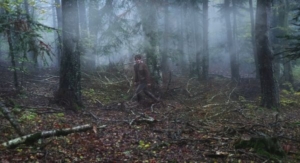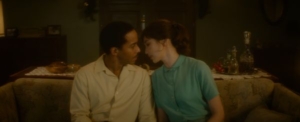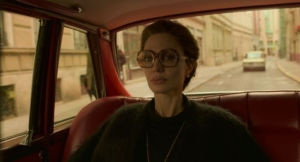From March 13 until the 17th, the Museum of the Moving Image will hold its 13th annual First Look festival, with a lineup of fresh and diverse international films, including some notable New York premieres. Three films from the lineup, Samsara, Sujo, and Achilles, offer remarkably vivid perspectives from different locales across the globe. With themes of animism and reincarnation, the excellent, experimental Samsara takes place in Laos and Zanzibar. Sujo and Achilles are more straightforward dramas, but are nevertheless equally distinctive works.
Samsara
It’s always a thrill when a film surprises, and Spanish filmmaker Lois Patiño’s Samsara, with its wandering perspectives, themes of animism and reincarnation, and use of immersive, sensory sound design, is a lovely and adventurous picture.
The vibrantly visual film starts in Laos with monks in meditation, which establishes the slow and contemplative mood and tone. We follow some of their day-to-day rituals, including the receiving of alms. Sometimes children lay side by side quietly, scrolling on cell phones (a little note of realism and humor that accentuates the film throughout). When the young novices sleep, the filmmakers interlay images of animals and fauna in tiles that scroll across the screen—one of many exquisite moments.
A young man, Amid (Amid Keomany), has been reading The Tibetan Book of the Dead to a dying elder woman, Mon (Simone Milavanh). Both he and a young monk he befriends, Bee An (Toumor Xiong), are finding their way in the world. Amid aspires to become a famous rapper. Bee An wants to keep studying at university and eventually work in IT. When Mon dies and her spirit travels, the film takes on a roughly 15-minute interlude that is unlike anything I’ve ever seen (and/or also not seen, as before it commences, an on-screen title instructs viewers to close their eyes).
The next section, set upon the bright shores of Zanzibar, concentrates on a group of women who scrub and dry out seaweed to be made for soaps (the idea of natural materials and spirits taking on different forms is a core theme). When a baby goat is born and named Neema, a grade-school girl Juwairiya (Juwairiya Idrisa Uwesu) takes it as a pet. It’s inferred that Mon’s spirit is within Neema, but could she also be in the red starfish the young girl sees on the beach, an animal Mon had mentioned earlier she wanted to be? (Neema’s winning performance is in the same caliber of recent beloved animal turns such as Messi in Anatomy of a Fall and the six donkeys in EO.)
Shot on 16mm Kodak film, the cinematography by Mauro Herce and Jessica Sarah Rinland is gorgeous. A scene of a small group of saffron-clad monks standing in the turquoise waters of the Kuang Si falls is simply breathtaking. But Patiño’s film feels more than an array of pretty snapshots. There’s a serenity, spirituality, and inventiveness in the piece that is exciting to behold.
Samsara is receiving its U.S. premiere as part of the First Look 2024 Series, and I hope the event will help widen the film to a larger audience.
Sujo
Affecting and involving, Sujo follows the titular boy from childhood into a precarious adulthood. Astrid Rondero and Fernanda Valadez, sharing directing and writing credits here, won the World Cinema Grand Jury: Dramatic prize at this year’s Sundance Film Festival. Also making its New York premiere, the coming-of-ager opened the First Look 2024 fest. (Rondero wrote their previous feature Identifying Features, and Valadez directed it.)
It begins in rural Mexican countryside, where Josue (Juan Jesús Varela Hernández) is a cartel gunman, a sicario. His four-year-old son, Sujo (Kevin Uriel Aguilar Luna, very sweet and believable), is enamored of his father, and the film occasionally narrows its images from a child’s perspective—specifically a car door lock in Josue’s car, which will become symbolic.
There are many tense moments, including Josue’s death, which happens near Sujo, though he does not witness it. Over the course of the story (told in chapters), he becomes a baby-faced teenager (now played by Juan Jesús Varela), kissing girls in the woods, partying with friends—mostly innocuous mischief. But soon he becomes intertwined with his late father’s business. To escape imminent danger, his aunt helps him flee to Mexico City, where he labors in a warehouse, hauling onions from trucks at night. By day, he wanders into a classroom, hoping to attend high school, and a dry, no-nonsense teacher, Susan (Sandra Lorenzano), takes him under her wing. Fortunately, the film avoids clichés and instead imbues Sujo’s life with subtle and authentic touches. Lorenzano plays Susan as steely, but not an overly exaggerated savior stereotype that often emerges in this kind of story.
Rondero and Valadez create an atmosphere of naturalism from the performances and atmosphere, including many haunting moments, such as Sujo first visit to his father’s grave or within his dreams, where ghosts casually and calmly appear, as if just walking by. And in one unsettling and stirring image, Sujo looks out of a bus window at a burning house at night.
In part a film about free will and determinism (something Susan is lecturing in one of her classes), Sujo relays larger issues and themes by exploring the intricacies and specificities through a youth’s singular tale.
Achilles
Somber, bone-dry, and sobering, Iranian filmmaker Farhad Delaram’s debut feature is a slow-burn survival tale of an unlikely pair, set initially in Tehran (and remarkably filmed on location, given its content). Thirty-four-year-old orthotist, Farid, nicknamed “Achilles” (Mirsaeed Molavian), is a former filmmaker disillusioned in creating art within a hostile, restrictive environment. He works in a crumbling hospital and becomes emotionally involved with a patient, Hedieh (Behdokht Valian). In a shadowy room of the psychiatric ward, she is in great mental distress, hearing voices on the other side of the wall. Injured in part from violently striking the wall, Farid tends to her injured wound. Having sympathy for her, Farid guides Hedieh out of the hospital, and the two escape to the countryside. Their drive and the film’s journey are a winding trek of uncertain destination.
On paper, Achilles could be a tense, on-the-lam thriller, but it’s more of a probing drama with characters who have irrevocable familial bonds. Characters talk slowly, taking purposeful, long pauses between talking. There is often much silence between Farid and Hedieh. Akin to its protagonists’ lives, the film is unrelenting in its drabness—dimly lit, with sand and olive tones. When we briefly see Farid’s bedroom where he grew up—his dry erase board of notes and a poster of Antonioni’s Il Grido—there’s suddenly a sense of life, color, promise, and hopes dashed. Quite eloquently throughout, a sense of claustrophobia emerges, illuminating the impossibility of breaking out. Its ending relays the power of capturing life on film, and becomes a tribute to those who risk political persecution and their lives to make art.



















Leave A Comment